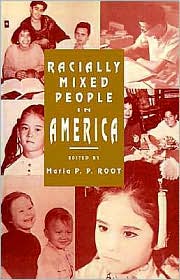Social Construction of Ethnicity Versus Personal Experience: The Case of Afro-AmerasiansPosted in Articles, Asian Diaspora, Identity Development/Psychology, Media Archive, United States on 2012-04-28 20:56Z by Steven |
Social Construction of Ethnicity Versus Personal Experience: The Case of Afro-Amerasians
Journal of Comparative Family Studies
Volume 29, Issue 2 (Summer 1998)
pages 255-267
Teresa Kay Williams
Michael C. Thornton, Professor of Afro-American Studies
University of Wisconsin, Madison
The article focuses on the existence of ethnic group differences in the U.S. and how the subgroup of Black Americans, Afro-Amerasians, situate themselves in an environment that attempts to place them within established racial boundaries. Afro-Amerasians are estranged between two forces: the contrasting push of society to identify them as only Black, and the pull of their own personal and unique experience. However, instead of succumbing to these forces, these groups developed a different kind of Black identity which incorporates other parts of their heritage. They choose to situate themselves on the traditional boundaries of racial groups rather than deny important parts of who they are; thus, they choose to be marginal. They grew up in environment where they had ample opportunity to develop. These people tried to make sense of their experiences as radicalized peoples. Their struggles with personal and social accepts of identity provide sociological insight into understanding the complexities and contradictions of race and their ever-changing meanings and applications.
There are two significant contributors to ethnicity or racial group identity: a thread of historical experience that is shared by each member of the collectivity, and a sense of potency/strength inherent in the group (see Phinney, 1990). In social science research, racial identity, ostensibly feelings toward the group, is rarely examined with explicit measures of group feelings. Usually, a racial label is correlated to psychosocial development of group members. In this regard, racial group membership – and not actual experience – is normally featured.
Thus, race is often used as a proxy for experience and attitudes, a practice embedded in premises of social science literature (Wilkinson, 1984). Deterministic views of race ignore important variations in how subgroups of Blacks relate to the larger group and to one another. Perhaps no experience better exposes the contradictions regarding how we view race in America than that of racially mixed individuals and, in particular, those with African heritage (Bonacich, 1991; King and DaCosta, 1995; Root, 1992).
Although a rare occurrence, interracial ties draw much attention because they encapsulate unresolved feelings and attitudes about race (Thomton and Wason, 1995). In a society racially stratified, where races are seen to be distinct, racial mixing has always been considered problematic (Spickard, 1992). Interracial populations muddy the dualistic view of race (i.e., that each of us is one or another race) and epitomize the inadequacies of this ideology; they lead us to question basic assumptions of how racial life is organized. In this article, we elaborate on this point by examining what would normally be considered a subgroup of Black Americans. We explore how Afro-Amerasians situate themselves in an environment that attempts to place them within established racial boundaries.
LITERATURE REVIEW
Black Group Identity
Work on Black group identity is not easy to characterize, in part because of relatively limited research on this issue, especially that which examines ethnic group differences (Porter and Washington, 1993). Typically, analysis highlights the influence of social class on identity (e.g., Landry, 1987; Farley, 1984). Some inquiry suggests that class is only a part of the puzzle. Broman et al. (1988) reveal that older, less-educated respondents in urban areas and highly-educated Blacks living outside the West were most likely to feel close to other Blacks. Gurin et al. (1989) show that identity, defined as common fate and as more Black than American, was not simply related to class. Males and those of upper-class status were more likely to feel a common fate with Blacks. Younger Blacks and those who did not work full-time were also more likely to feel more Black than American.
Usually, these studies implicitly assume that group identity is a globally positive (or negative) feeling toward a homogeneous racial referent (Allen et al., 1989). This view fails to recognize that subgroups of Blacks have attitudes about various groups within the racial category (e.g., poor versus middle-class Blacks). It is also common, within this perspective, to treat Blacks as having assimilated and thus not see identity as an alternate cultural experience (Porter and Washington, 1993). These assumptions result in an approach that rarely sees group attitudes as an admixture of positive and negative feelings. This approach does not allow for the possibility that group attitudes may involve an affinity with some aspects of subgroups within the racial category, even while coupled with attempts to disassociate from others (McAdoo, 1985; Jackson et al., 1988; Cross, 1991).
However, an ambiguity toward the racial group might be expected for minorities who contend with negative images of their group permeating society. Some emerging works identify several reference groups within the overarching racial category. Allen et al. (1989) describe identity as containing two important referents: masses (non-mainstream) and elites (mainstream). They suggest that within the racial category is an array of boundaries and identities prioritized in a variety of ways. For example, case studies show that native Black Americans distance themselves from Black Haitians (Stafford, 1985).
Multiracial Identity
Blacks will have different views of Blackness depending on where they are positioned in the social hierarchy. The position we consider here is mixed racial heritage. Historically, this category was simple. Mixed race referred to Black-White offspring who were part of a two-tiered system: Whites and Blacks, with racially mixed people viewed as improved versions of Blacks. Changes in the racial composition of the United States have been the catalyst of emerging work accenting race relations as inclusive …


